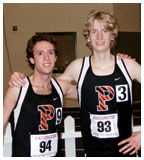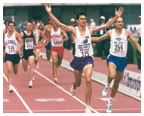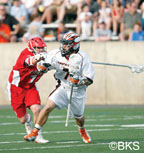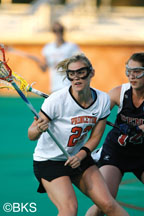
|
May 14, 2008: Sports
Still kicking
Marsch ’96 has built a career in America’s top soccer league
Men’s lacrosse stuns Cornell
Tigers improve to 4–0 against Ivies
Sports Scores — Updated weekly
MORE SPORTS ON THE BLOG, click here.
Still
kicking
Marsch ’96 has built a career in America’s top
soccer league
By Giles Morris ’97
Jesse Marsch ’96 is not one of the most famous players in Major League Soccer, but over the last decade he has built one of the league’s most remarkable careers. The former collegiate All-American is one of only four players to have played in all 12 MLS seasons. When he left the Chicago Fire in 2006, he was the club’s all-time leader in games played (200), and as the current captain of Carson, Calif.-based Chivas USA, Marsch is still at the top of his profession.
“I didn’t have any long-term goals at first as much as I just wanted to see what the league was like, and I wanted to keep trying to play,” Marsch said of his start in pro soccer. “There were a lot of experienced guys at DC United [Marsch’s first team] who had been pros for a long time, and after about six months, I realized I could make a living at it.”
Marsch made only 15 appearances in his two years with DC United, but his playing career took off after he reunited with former Princeton coach Bob Bradley ’80 in Chicago, becoming a regular fixture on a team that would win the 1998 MLS Cup. The relationship with Bradley — now the head coach of the U.S. men’s national team — began in Marsch’s senior year at Racine Case High School in Racine, Wis., when Bradley came to recruit him. “My first impression of Bob was that he was different, in a good way,” Marsch said. “He cut through all the crap. He was honest and genuine and smart, and I could tell that right away. I’m thankful I had the opportunity to meet him at that age, and I feel lucky that I figured out back then that he was a good man.”
Marsch remained a standout midfielder for the Chicago Fire from 1998 through 2005. During that time, he considered going to business school or switching careers, but the idea did not last long. “Right about when I turned 28, I realized I didn’t want to do anything else,” he said. “There are those days when it’s raining a little bit and you wake up and go out there and start moving and the ball’s whizzing around. ... Those are perfect days, and I thought I would really miss that if I left.”
Having played in MLS from its beginning, Marsch enjoys an uncommon perspective on the league’s development. At first, he said, players simply were happy to be pros, staying in nice hotels, playing in big stadiums, and getting paid. But times have changed. “The last two years I’ve seen things I thought I’d never see,” Marsch said. “A new stadium in every city. David Beckham. TV contracts. We’re not far away from being a big-time league.”
Princeton may not produce many professional athletes, but Marsch believes his experience on campus has been a key to his success. While his relationship with Bradley has been central to his playing career, the values he learned as a student-athlete at Princeton have been as important, he said. “I think the greatest experience Princeton rewards you with is the opportunity to grow up with your peers in a small environment,” Marsch said. “I was humbled in a lot of different ways by Princeton, and those experiences shaped who I am today and how I conduct myself.”
Marsch, now 34 years old and married with three young children, knows
that his playing days are numbered. But he intends to stay in the game
as a coach. “I know opportunities will come my way,” he said.
![]()
Giles Morris ’97 is a reporter at the Rhinelander Daily News in Rhinelander, Wis., and writes fiction in his spare time.

David Nightingale ’08, left, and Michael Maag ’09 first threatened the four-minute mark in 2007. (Courtesy Steve Dolan)
Bill Burke ’91, shown with arms raised at the 1993 USA Track and Field Championships, ran Prnceton’s only sub-4:00 mile by an undergraduate. (Courtesy Bill Burke ’91) |
Breaking
4:00
A historic barrier still resonates, but today’s stars have fewer
chances to run the mile
By Merrell Noden ’78
The mile run holds a special place in the imagination of track fans. “There’s the 100 for speed, the marathon for endurance, and the mile is the perfect mix of both,” says Bill Burke ’91, who is, for now, the only Princeton student ever to break four minutes for the mile, having run 3:58.70 at the 1991 Millrose Games in Madison Square Garden. “It’s got a certain mystique about it.”
Some of that mystique comes from the neat symmetry of the mile’s four quarter-mile laps and the exquisite tension they often create. But it’s also due to the allure of the four-minute barrier, once reckoned to be beyond human achievement. That’s been proved wrong literally thousands of times by now — the world record is 3:43.13 — but four minutes is still one of the few marks in any sport that means something to the average American. “People always ask your mile time — right after they ask you if you’ve ever run a marathon,” notes Michael Maag ’09. “Four minutes will get you street cred.”
Maag is one of three Princeton milers who seem to have a real shot at breaking four minutes this spring — if only they can find a mile to run. Somehow — perhaps as an unintended consequence of our halfhearted attempts to go metric — the mile has begun to disappear. It is still a standard distance at indoor meets, but outdoors, the 1,500 meters, about a football field short of a mile, gets contested almost exclusively. That’s why Princeton’s outdoor mile record, the 4:04.2 Craig Masback ’77 ran in 1977, is so much slower than Burke’s Millrose time: Neither had many chances to run the mile outdoors. (Both would run faster after graduation, Burke clocking 3:56.83 and Masback 3:52.02.)
The difficulty in finding mile races is particularly galling to Princeton track fans this spring, because the Tigers never have had a stronger group of milers. Last year, David Nightingale ’08 and Maag came within a whisker of breaking the magic mark, clocking 4:01.61 and 4:02.40, respectively, at the Husky Classic, an indoor meet in Seattle, while a third, James O’Toole ’08, ran 3:45.69 for the 1,500 meters, roughly equivalent to a 4:04 mile. This year, with Nightingale nursing injuries, Maag returned to the Husky Classic and lowered his best to 4:00.43. An injured foot may prevent him from trying again this year, but he should get another shot next year.
“That was one of the nice things about chasing it as a junior,” says Maag, an economics major from Lake Oswego, Ore. “You know you’ll have another chance so the pressure’s not bad pressure, just good jitters.”
For Steve Dolan, who coaches Princeton’s middle-distance runners, this is a special group. His first year at Princeton was Nightingale and O’Toole’s freshman year, while Maag was in his first recruiting class. All were very good runners in high school but have improved dramatically at Princeton. Nightingale, a politics major from West Hartford, Conn., who first ran track as a high school junior after playing tennis as a boy, is running the same time for the mile that he once ran for the 1,500. But his best event may well be the 5,000 meters. The same also might be true for Maag.
O’Toole may be the one pure miler of the three. He’s also a historian of the sport. He dedicated his history thesis to his teammates, using a quote from track team manager Peter Schwed ’32 about Bill Bonthron ’34 and his famous mile against Glenn Cunningham at Palmer Stadium in 1934: “[S]ince the mile event wouldn’t be run until six o’clock that Saturday afternoon, [Bonthron] decided that he need not forego his customary weekend program. Accordingly, he played 18 holes of golf in the morning, and followed it with his regular hot-weather luncheon — a quart of vanilla ice cream.”
Princeton and Palmer Stadium were important in what one might call the “mythification” of the mile. The invitational miles that athletics director Asa Bushnell ’21 built around Bonthron in the mid-30s drew tens of thousands of spectators and produced two world records, though, sadly, neither by the hometown hero. “Bonny” had the hard luck to finish second on his home track to a world record twice — first to Jack Lovelock, a Rhodes scholar from New Zealand who would go on to win the 1,500 gold medal at the 1936 Olympics, and then to Cunningham. Bonthron would get his revenge against Cunningham soon after graduating, beating him in the national championship 1,500 in a world-record 3:48.8.
Those three weren’t the first milers, but they were the first who mattered, as milers, to the public. According to author James McNeish in his novelized biography, Lovelock, Bushnell’s Prince-ton meets gave us “the first serious mention of a concept called a Four-Minute Mile — which until Bushnell’s day had hardly even been dreamed of.”
More than 70 years later, for this generation of Princeton milers, the
dream endures. ![]()
PAW contributor Merrell Noden ’78 ran his best mile in 4:11.2.

Tommy Davis ’09 (Beverly Schaefer) |
Men’s
lacrosse stuns Cornell
Tigers improve to 4–0
against Ivies
By David Marcus ’92
Coach Bill Tierney said his men’s lacrosse team’s 11–7 victory over No. 3 Cornell April 19 was one of the biggest regular-season wins of his 21-year tenure. Not only did the game give Princeton the inside track for the Ivy League title and the automatic bid to the NCAA playoffs that goes with it (likely the Tigers’ only chance at the postseason this year); it also snapped a four-game losing streak to the Big Red, who won the Ivy title outright in 2005 and 2007 and shared it with Princeton in 2004 and 2006.
Princeton won despite the absence of midfielders Mark Kovler ’09, the team’s third-leading scorer, and Rich Sgalardi ’09. Bob Schneider ’08 picked up the slack, scoring three of the Tigers’ first four goals against Cornell. Tommy Davis ’09 also netted a hat trick, and Peter Striebel ’08 and Jack McBride ’11 each scored twice. Princeton’s offense showed significant improvement from its previous three meetings with Cornell, when the Tigers had managed just 13 goals combined.
Princeton’s defense played as well as it has this year despite
the significant edge in time of possession that the Big Red earned by
winning 16 of 21 faceoffs. The two key stops came in the first and third
quarters. Goalie Alex Hewit ’08 saved a shot from close range to
keep Princeton within 2–0 early in the game, and he added two more
saves in the middle of the third quarter after Cornell had scored twice
in a row and seemed primed to make a run. ![]()
David Marcus ’92 is a frequent PAW contributor.

Christine Casaceli ’09 (Beverly Schaefer) |
After opening with a perfect 10–0 record, WOMEN’S LACROSSE lost back-to-back games against Penn and Dart-mouth on April 16 and 19. The Ivy League-champion Quakers scored five goals in a seven-minute stretch early in the second half, and goalie Sarah Waxman held Princeton to one goal in the first 44 minutes of what would be a 9–5 Penn victory. “[Waxman] did a nice job, but we didn’t challenge her nearly as much as we could have,” head coach Chris Sailer said afterward. Christine Casaceli ’09, left, had a goal and two assists in the loss.
Against Dartmouth, the Tigers came back from a four-goal deficit late in the game and appeared to tie the score at 13–13 on Ashley Amo ’08’s goal with 1:20 remaining. But Amo’s stick was ruled illegal after the play, and the Big Green held on to win 13–12.
Through 16 Ivy games, SOFTBALL posted a 15-1 record, setting up a final-weekend showdown with 15–1 Cornell for the South Division championship. Kathryn Welch ’09, Kelsey Quist ’10, and Jamie Lettire ’10, Princeton’s No. 3, 4, and 5 hitters, have combined to hit 21 home runs and drive in 53 runs while batting .446 in league games.
With six games remaining, third baseman Spencer Lucian ’08 was on track to be the BASEBALL team’s second .400 hitter in as many seasons. Lucian, a .422 hitter through Princeton’s first 36 games, struck out just nine times in 128 at bats.
Susannah Aboff ’09 of the WOMEN’S GOLF team won the individual title at the Ivy League Championships April 19–20, beating her nearest competitor by 11 strokes. Aboff was 9-under-par in 54 holes at the par-72 Atlantic City Country Club and shot an Ivy-record 65 in the tournament’s opening round.
CRAIG ROBINSON ’83, who led the Brown men’s
basketball team to a school-record 19 wins in 2007–08, was named
head coach at Oregon State April 7. At an introductory press conference,
Robinson said it was “nice to be back,” noting that he had
played his last two college games at Oregon State’s Gill Arena in
the 1983 NCAA Tournament. ![]()




